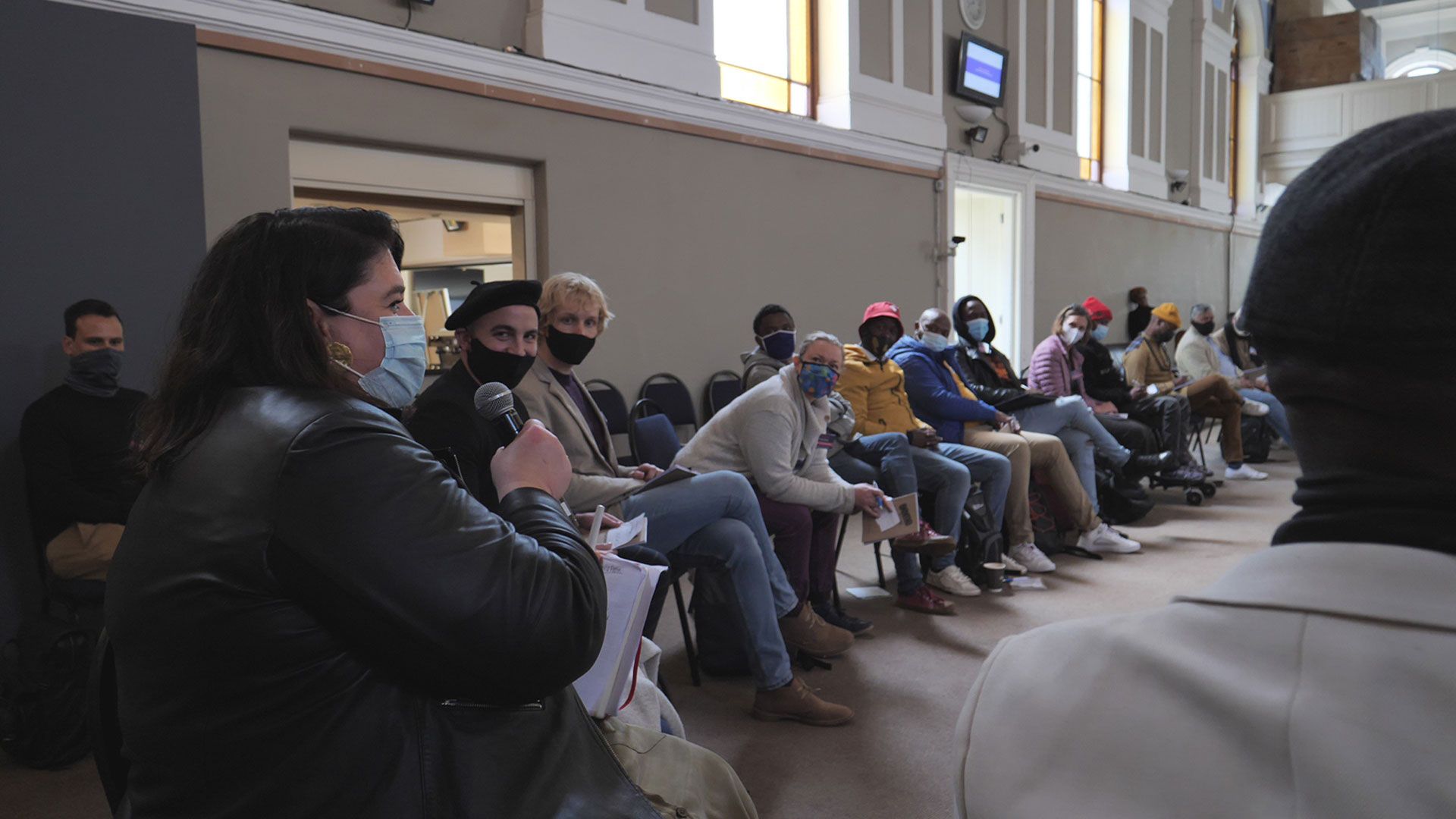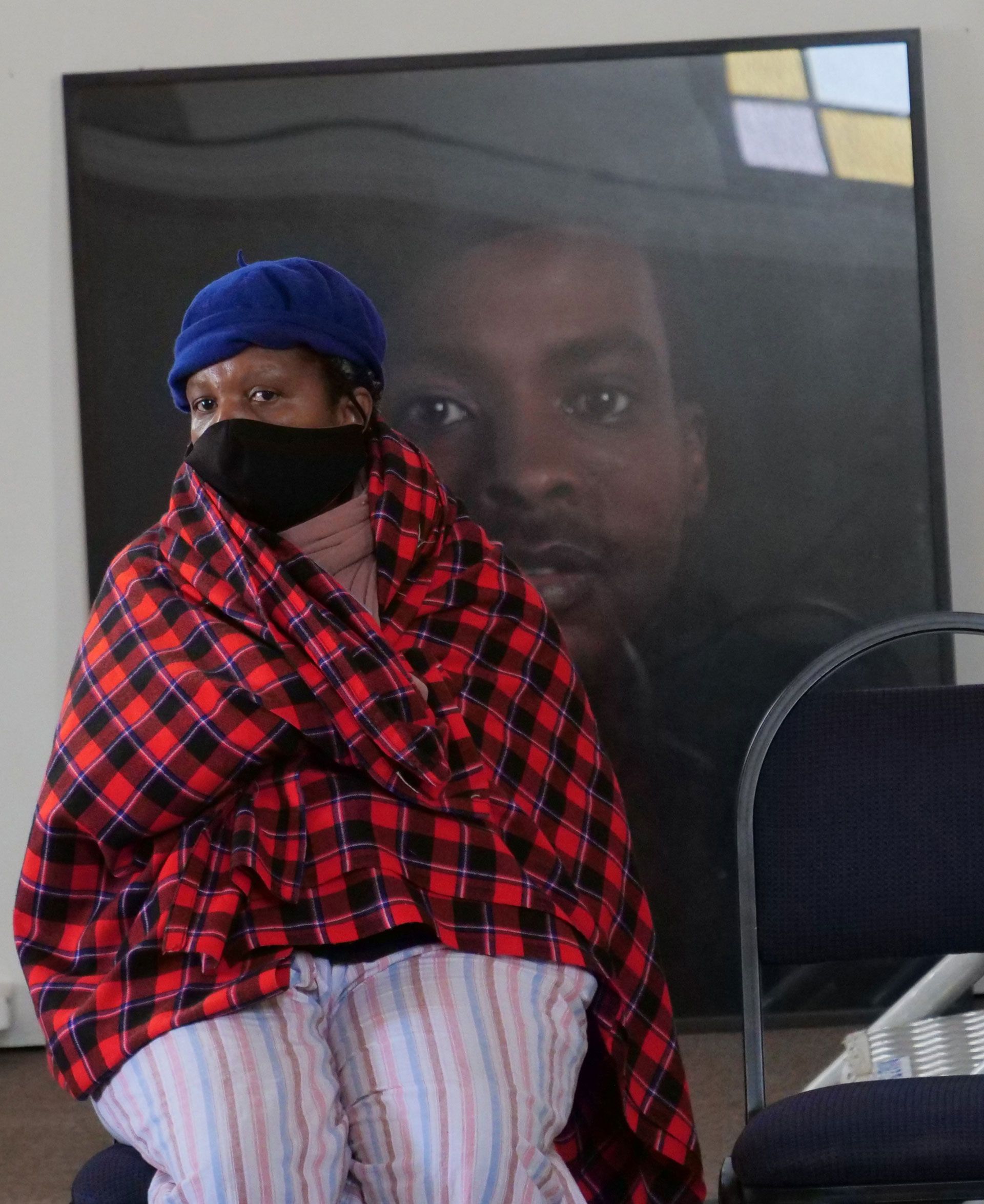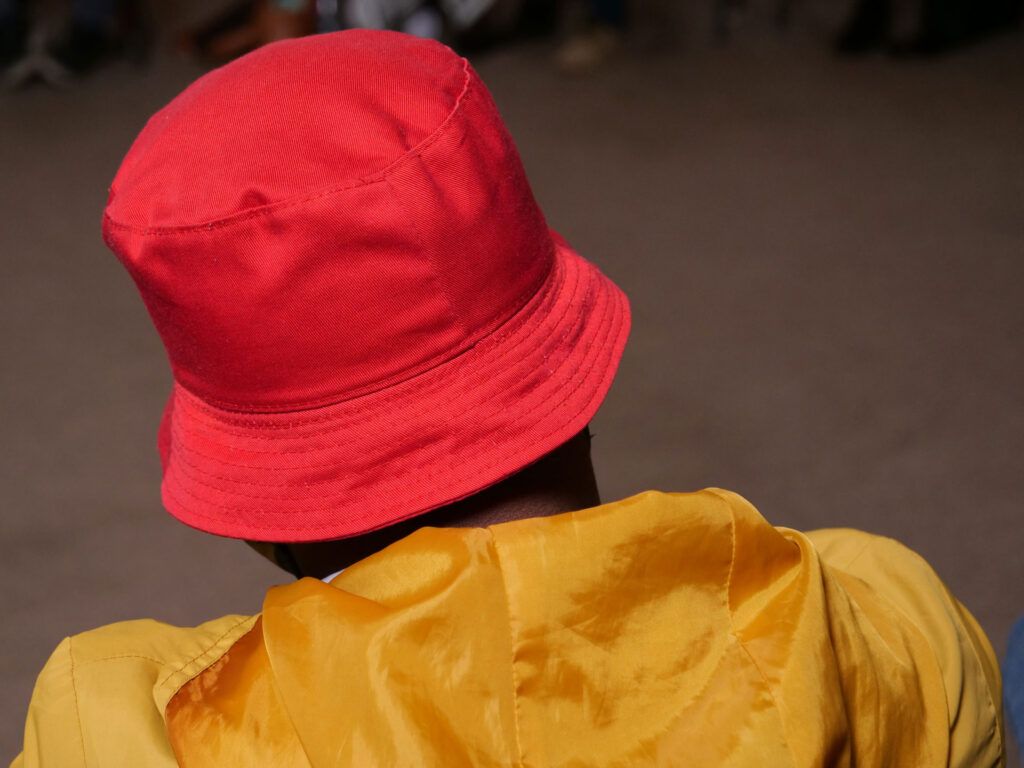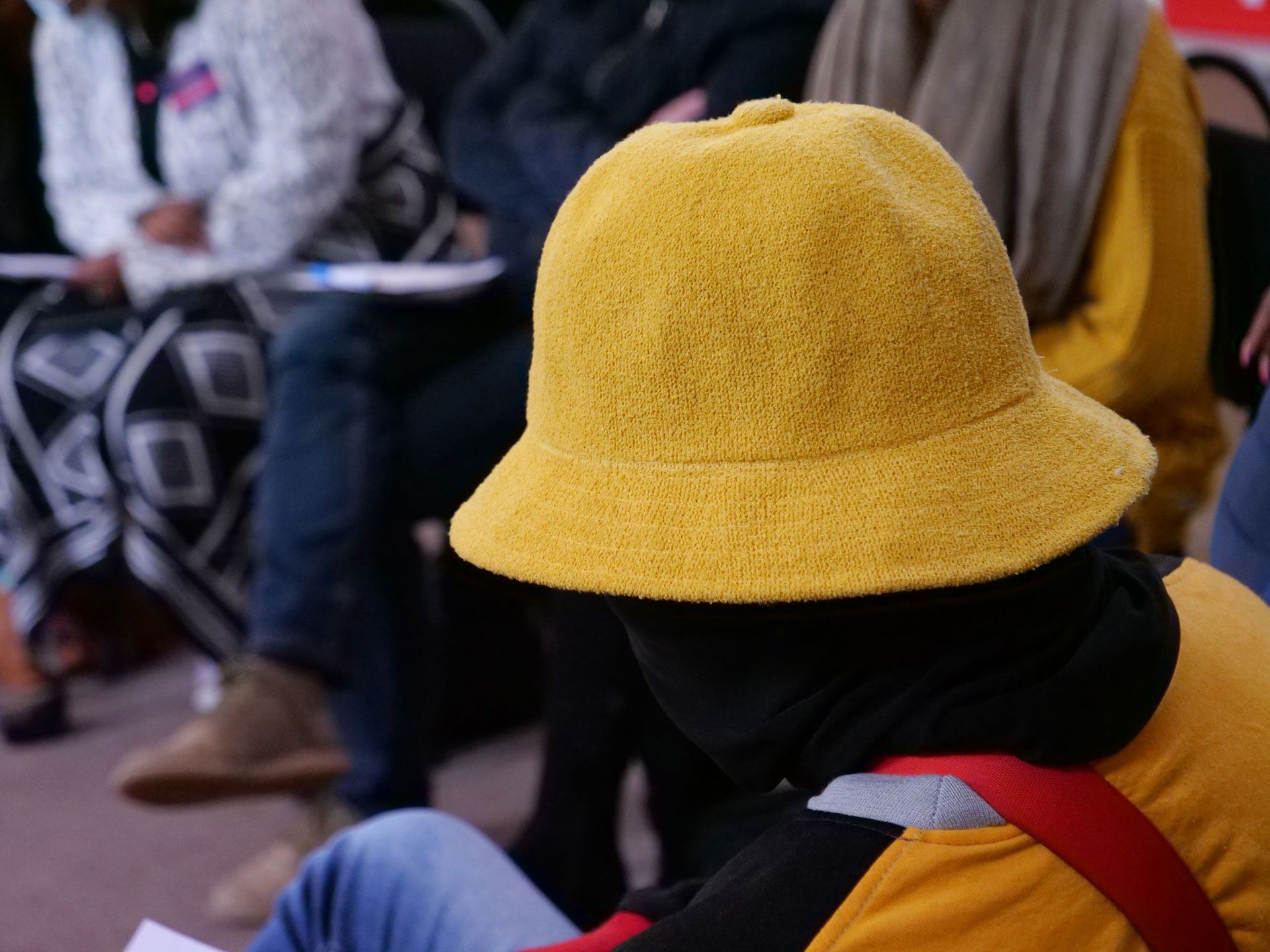BRIDGET RENNIE-SALONEN & YVETTE HARDIE
Creating a healthy arts sector ecosystem: The Charter of Rights for South African Artists
“Commitment to moving forward together” is the title of Resolution Six adopted at the pivotal national #STANDTogether Arts Summit, which was held from 20 to 22 September in Stellenbosch, South Africa (SA). As the final of the six powerful and comprehensive resolutions that were the outcome of the summit attended by representatives of 33 arts organisations, across genres and disciplines, it outlines the implementation of concrete steps for building communication, trust, and collaboration within the SA arts and culture sector, and with society more broadly, including media engagement.

In the spirit of moving forward together, the recent Charter of Rights for SA Artists was a keystone in the debate throughout the summit, providing a roadmap for interrogating and defining shared values to underpin the entire sector. Some of the themes which emerged were community building, with mutual upliftment, respect, and compassionate understanding, as well as the promotion of artists’ rights, utilizing the Charter of Rights for SA Artists.

In his opening keynote address, Mike van Graan spoke to the assembled artists, stating: “We have a duty to help our fellow citizens make sense of this world, to interpret and reflect, to help our audiences to experience catharsis, to speak truth to power and somehow, somewhere, to find beauty, to affirm life. Even though we, too, are not well.”
While artists play their vital role in societal healing, how can they not be well, one may ask? Although the Covid-19 pandemic is a core component of the current biopsychosocial and economic ill-being of individual artists and the whole arts ecosystem, the ill-being is exacerbated by lack of government support, suitable legislative frameworks, and strategic well-managed funding for the arts.

The Healing and Wellness theme at the summit was led by Bridget Rennie-Salonen of the new South African Performing Arts Health Association (SAPAHA), formed to serve the health and well-being of SA artists through representation, collaboration, multidisciplinary research, advocacy, resources, and education. Although health and well-being is a distinct topic, impacting artists as individuals, it is simultaneously the ubiquitous collective element for us all in the creative industries sector. In the midst of the calls for artists’ equality, transformation and social justice are the intertwined calls for artists’ well-being. Yet until now in South Africa, these well-being calls have been largely inaudible, unheard, and if heard, unheeded. Why did no one pay attention? Perhaps the industry’s culture has been to hide the pain, to push on in silence, to bear the status quo, or to ‘just leave if you can’t take it’. How many have left the sector because of this? We’re good at masking.
But the voices must be heard, and the masks removed.
The stories of creatives facing insurmountable challenges must be told. These are the ‘reality show’ of the creative depletion, the insidious perils, the unsustainable careers: the loss. We need to know about them. We should talk about them and interrogate why they play out like this. Who is responsible? How can we take shared responsibility? What can we do to facilitate a paradigm shift in the arts sector to promote non-threatening dialogue, engagement, mutual support, resource building, expansive creative thriving, cultural abundance, and health promotion through and in the creative arts? Who is involved; top-down, bottom-up, outside-in, and inside-out? What are our values?

First, let us hear a few of the stories, to make us slow down, look, and listen.
Zinzi was a jazz singer who lost all her gigs with the band which was her main work source, because she developed recurring vocal hoarseness and pain with frequent loss of vocal agility and control. Not knowing who to turn to, being without medical aid as she was a freelancer, she had primarily self-medicated, and just pushed on harder, leading to further vocal damage. By the time she went to an ENT, vocal surgery was the only way forward, which she could not afford. Her career as a vocalist was over. What if Zinzi had known about a vocal coach who worked with an ENT specializing in vocalists’ needs, and was able to address the issue proactively? What if Zinzi had felt safe disclosing her vocal injury to her colleagues earlier on, without fear of being labelled as ‘damaged’?
Zinzi’s story relates to Rights 1, 9, 10, 11.
Clive is/was a modern dancer who had worked full-time in a thriving dance company, before it collapsed due to funding cuts causing all the employees to lose their jobs. He had danced since he was 4 years old – it was all he knew – and his life and identity centred on dance. He lost his self-esteem and self-confidence, and despite developing his entrepreneurial skills, and trying to re-create himself as a freelancer across a range of dance styles, he was financially ruined. Work was scarce, and when there was work, fees were low and exploitative. He suffered severe clinical depression, moved in with an abusive partner on whom he was dependent, all leading to alcohol and substance abuse. He danced now and again, eking out a meagre existence, and was lauded in the media for his superb talent, virtuosity and artistry, but within himself he was destroyed. He was alone and devastated, feeling abandoned by the profession he so loved, had trained so hard for, and could do so well. He was ostracized by his peers because of his lifestyle, and gradually even lost his network which had brought in the gigs. He died by suicide. What if Clive had known who to turn to, for financial planning and mental wellbeing counselling for artists? What if there were better regulated fee structures which had enabled Clive to make a living as a freelancer? What if he had felt respected as a performing artist, with a valuable contribution to society?
Clive’s story relates to Rights 1, 2, 5, 11
Tebogo is a brilliant sound engineer. After 15 years in the live sound and theatre industry, he has found out that he has noise-induced hearing loss (NIHL), with additional related symptoms such as tinnitus and pitch distortion. He was interested in hearing health during his tertiary training and had suggested that an audiologist be brought into the college where he studied, to teach the students about hearing protection, environmental sound level management, and to give them all audiometric baseline assessments. The college did not have the resources to do this, although they saw the value in the recommendation. At age 39, and with a young family, Tebogo is now needing to re-consider his future, as he cannot do his job properly anymore. Does he qualify for disability compensation? Who is responsible for his NIHL? Can he still work in a related field in the arts sector? What is the cost to society and to the cultural sector for a work-related injury that could have been avoided?
Tebogo’s story relates to Rights 3, 9, 10, 11
Charmayne is a multi-genre pianist and accompanist. Her work includes being a part-time music teacher at a school, being the pianist for a well-known contemporary commercial voice studio and doing freelance gigs with her band. She experienced a repetitive strain injury in her wrist during a very busy period when her playing workload had suddenly increased. She had pushed through the initial pain and warning signs, because ‘the show must go on’ and because she feared losing work due to the stigma and shame perceptions attached to a playing-related injury. In desperation, when the pain became severe, she went to see a physiotherapist, who referred her to an orthopaedic hand specialist. Both advised 8 weeks of total rest from piano-playing, together with wearing a wrist splint, followed by a graded return-to-play protocol over 3 months. What should she do? She is afraid of telling anyone in her freelance musician network, for fear of losing gigs, and being seen as unreliable and weak. She is rightfully worried about losing her part-time ongoing jobs, and having to resign, as she is not entitled to employment benefits such as paid or unpaid sick leave. Who should she consult? What if our labour legislation acknowledged artist’s work-related injuries?
Charmayne’s story relates to Rights 2, 3, 10, 11
Lerato was a senior stage manager. In her work, as she had access to production documents which included budgets, she noticed frequent accounting irregularities. She publicly criticised an influential arts manager, due to their exploitative financial practices towards the artists they employed. She now cannot get work, has been unfairly and untruthfully discredited, and labelled as a disgruntled whistle-blower. Who can Lerato turn to? What if there were structures and procedures in place? What if there was transparency and regulation of fees? What if there were consequences for arts managers for infringements of the regulatory fee structures?
Lerato’s story relates to Rights 5, 8, 10 12
Damon is a drummer. He was sought after as a freelancer, very well-known and played in a high-profile rock band, living a fast-lane life. Soon after a publicly exposed substance abuse scandal, he died in a high-speed car-accident. What are our industry values? How do artists navigate the expectations within the industry? How do artists support or compete with one another? Does our performing arts sector implicitly promote an ‘all-or-nothing’ ethos, where overnight fame is as common as overnight obscurity? Is a fast-lane lifestyle what it takes ‘to make it’ and be popular? Is the desperate commercialization of the arts driving fast profit models which undermine art for art’s sake?
Damon’s story relates to Rights 1, 2, 3, 6
Sam is a playwright, who writes scathing and hilarious critiques of contemporary society and politics. However, he is struggling to find government funding for producing his work, as it is known to be critical of the ruling party. As a result, he has turned to private funders, and his works play in independent venues and at festivals, since the state institutions also seem to overlook his work due to its controversial nature. Working in this way, he is barely making ends meet, despite the excellent reviews, and decides to add writing for television to his resume in order to be able to pay his bills. He has an idea for what he believes will be an excellent (and commercially viable) television production and pitches it to several stations including the state broadcaster. He is not successful, but some months later, a television production airs which is remarkably like his original concept in all respects – apart from the fact that he is not being credited or paid for the work. To whom does he turn?
Sam’s story relates to Rights 4, 6, 7, 9
Sizwe runs a successful arts NGO, which combines making excellent productions with strong themes relevant to local communities with an award-winning educational outreach programme. He is adept at applying for funding from local, provincial and national government, and is often successful in getting a grant from these entities. However, when he applies for a grant from the city where he is based, he is asked to provide a kick-back to the local city arts manager to ensure success. He refuses to do this, and the grant is withheld. Thereafter he starts to find that his funding has dried up, wherever he turns. He is less successful with grant funding than before and has to retrench his administrator and several of his educational facilitators the following year. He is finding it harder to remain compliant, as he doesn’t have the funding to cover his annual financial audit. How can his arts organisation survive in a hostile climate?
Sizwe’s story relates to Rights 1, 2, 6, 13
Sheila is a visual artist and single mother, who finds it extremely difficult to fund her artwork, which is expensive and time-consuming to produce. She has managed to build up a strong body of work and is looking for representation, but she finds that galleries and agents take high commissions for their sales, and she doesn’t have the skills needed to market and sell her work directly. Waiting for sales means that her income is extremely unpredictable, making it difficult to maintain monthly debt payments and pay for her children’s education. Some of her earlier work now fetches higher prices when sold on from one purchaser to the next, but she does not benefit from this increase in value. How can she become more financially healthy in this environment? What can be done to ensure that re-sale royalties are in place so that she can benefit fairly from her work in the future?
Sheila’s story relates to Rights 2, 3, 5, 7
Thando is a freelance performing artist, an actor and musician. When COVID-19 hits, the production that he was due to be in is cancelled, but he had not received a contract for the work. He is unable to apply for the first wave of relief from the Department of Sports, Arts and Culture (DSAC), as he has no proof of this intended work. He is unable to make money through gigs, since performance venues are closed. He has no income and has to borrow to survive. He loses his flat and has to squat with family members. The second wave of relief from DSAC promises a once-off payment to artists of R6600 for a three month period. He is desperate for any support. The requirements which include providing certified documents, work references, bank statements and a tax compliance certificate cost him over R1000 to source and send, due to needing to pay for transport, photocopying and other costs. However, he is not tax compliant and his application is rejected. He is left worse off than before. He becomes severely depressed. What would happen if the relief funding had been more carefully designed to be accessible for the artists who desperately needed it? What if a proper database of artists existed which allowed anyone earning from artistic practice to register for purposes of regulation? What if government really understood the contexts of artists and responded compassionately and strategically?
Thando’s story relates to Rights 1, 2, 3, 11
Mathotho organizes an artist protest outside a government institution to rally around the need for support for artists, debilitated by a COVID-environment. She has worked with others in their organisation to develop a comprehensive plan for how COVID-relief could be distributed more effectively for artists which she wants to submit to government. Only a few artists attend the protest due to the fact that they do not have money to transport themselves there and they also feel intimidated by recent responses of government to artists’ protests. Artists have been harassed by police, when attempting to deliver memoranda to government, and are answered by a show of brute force rather than constructive engagement from the departments from whom they are requesting answers. Mathotho is concerned that she may now be targeted. What alternative modes of engagement could there be for artists to express their concerns and engage with policy makers constructively? How should government facilitate dialogue with artists? Who should be allowed to have “access” to decision-makers – only the organisations that government has endorsed or all organisations with legitimate memberships? What form should these engagements take in order to ensure meaningful progress is made?
Mathotho’s story relates to Rights 1, 8, 12, 13
These fictional vignettes were adapted from real stories. They provide a glimpse into scenarios that could have been prevented if health and wellbeing, in the broadest sense, were considered, in the arts sector. Sustainability depends on healthy individuals, healthy organisations, and healthy societies. Without health and wellbeing, the system crumbles. Health promotion, the term from the public health sphere meaning ‘keeping people healthy’, provides a lens through which to examine multiple facets of the arts sector. Importantly, health promotion both through the arts and within the arts must be taken into account.
So, what can we do to build a healthy arts ecosystem? What is a biopsychosocial ecological perspective?
A biopsychosocial approach integrates biological, psychological, and social factors in their influence on health and disease (Bolton & Gillett 2019). An ecological perspective on a particular population, sector, or organization considers both an individual’s characteristics and the environmental aspects pertaining to behaviours and their reciprocal causation (McLaren & Hawe 2005). Ecological models in the study of health promotion therefore address “not only individual behaviors and their cognitive determinants but also the multiple settings and social contexts that shape behaviors, including larger social and cultural dimensions” (Richard, Gauvin & Raine 2011: 308). Context includes physical, social, cultural, and historical aspects, as well as local and global influences (McLaren & Hawe 2005).
These contextual and multilayered characteristics can be represented graphically, often shown as multiple concentric rings, each as a level of influence with mutual interaction. The levels include the intrapersonal component, interpersonal aspects, organizational elements, community, and policy (McLaren & Hawe 2005).
From the outer macro- to the inner micro-level, the arts sectoral web is linked with enmeshed health fibres.
For example, the economic health of the sector as a whole links directly and indirectly through to the occupational health and wellbeing of the artist as an individual, which links to their optimal artistry, creativity and creative output.

The markers of a healthy ecosystem include being self sustaining, resilient, balanced, and stable, able to maintain organization and function over time, and with greater diversity tending towards greater productivity, and a more sustainable and stable ecosystem. Unfortunately, these features are markedly lacking within the current arts environment, if they were ever there; what we have instead is a haphazard environment, with poor articulation between its constituent parts, which results in the suffering of individual artists and groups of artists, who inevitably fall between the cracks.
Ecosystems are inherently complex, with a myriad of interconnections and linkages.
In designing better conditions for the arts and culture sector, we need to bear in mind the many moving parts, and particularly focus on how they can connect more meaningfully. (Richard et al. 2011) note the dynamic complexity of an ecosystem with its “interdependence, cycling of resources and succession”, and how a framework can thus be developed for research and intervention in a particular community through a collaborative and participatory approach.

The vignettes above indicate the complexity and diversity of conditions and needs within the sector. These play out in a landscape where extreme inequity drives vast health disparities in an unbalanced healthcare system (Benatar 2013). However, what is also evident throughout these vignettes is that a certain overarching ethical framework is lacking. Some of the factors oppressing artists are in fact of their own making or a product of the inherited environment in which they work. Poor practices within the industry include unhealthy types of competitiveness, ongoing financial exploitation and the replication of negative cycles of unsustainable and limiting sectoral practices. Some of these include micro-oppressions experienced within working environments, some are linked to unrealistic expectations such as “the show must go on”, or to persisting negative tropes that exist within the general populace but are often internalized by artists, such as “the starving artist” or “the self-indulgent artist”.
The battle for a better ecosystem for arts and culture is a global one.
In 2020, American BIPOC theatre workers came together to create a manifesto and a call to action, known as “we see you White American Theatre”, which spelt out the values, principles and demands that marginalized theatre workers were rallying around. The movement has grown to tens of thousands who are now signed up to its credo and it has done much to demand accountability in mainstream organisations and venues across the USA. In Australia, the Arts Law Centre provides a free and discounted service to all artists, providing education, legal advice, advocacy on issues affecting indigenous artists and communities, and case studies which allow artists to make better decisions about their careers and the options available to them. In Malta in 2020, artists organised themselves into the Malta Entertainment Industry and Arts Association, to bring together all creators, performers, promoters, producers, suppliers, educators and technicians, in order to lobby for better conditions for artists in the country. Some of their innovative demands are to extend an existing 150% tax deduction for donation by companies to cultural NGOs to projects by private operators in the entertainment industry, and to implement a reduced income tax rate for artists. They are also calling for “arts on prescription” which would support specific health conditions such as mental health to enhance wellbeing and lessen isolation, especially in the aftermath of COVID.
Here in South Africa, the coalition represented by the #STANDTogether Arts Summit and The Charter of Rights for South African Artists, provides a framework from which to begin this fundamental work.

Spotlight on The Charter of Rights for South African Artists
Download a PDF of the Charter here:
The introduction to the charter sets the foundation for the values that are integral for a healthy arts ecosystem. It defines the artist population and outlines contextual values in the form of universal rights with regard to aspects such as human rights, status, diversity of cultural expression, and freedom of expression. Following on from the introductory section, the rights of artists are asserted in full.
The Charter for the Rights of South African Artists provides us a framework from which we can start to combat the factors that contribute towards the ill-health of our current ecosystem. The publicization of, advocacy for, and education on the Charter should be aimed both within and outside of the creative industries and includes critical engagement with everyone, from the individual artists all the way up to government and policy organisations.

As Eleanor Roosevelt said, “Where, after all, do universal human rights begin? In small places, close to home – so close and so small that they cannot be seen on any maps of the world. Yet they are the world of the individual person; the neighbourhood he lives in; the school or college he attends; the factory, farm, or office where he works. Such are the places where every man, woman, and child seeks equal justice, equal opportunity, equal dignity without discrimination. Unless these rights have meaning there, they have little meaning anywhere. Without concerted citizen action to uphold them close to home, we shall look in vain for progress in the larger world.”
And so it is for artists. We need concerted citizen action to uphold these rights in the studio, theatre, gallery, cultural centre, classroom, and public spaces, but equally we need supportive legislation to ensure that those who violate or disrespect these rights are held to account. The arts are a barometer of the well-being of the nation, and without a healthy arts and culture sector, there can be no healthy individual or society.
To express support for the Charter, click here.
Benatar, S. 2013. The challenges of health disparities in South Africa. South African medical journal. 103(3):154–155. DOI: 10.7196/SAMJ.6622.
Bolton, D. & Gillett, G. 2019. The Biopsychosocial Model of Health and Disease: New Philosophical and Scientific Developments. Springer International Publishing. DOI: 10.1007/978-3-030-11899-0.
McLaren, L. & Hawe. P. 2005. Ecological perspectives in health research. Journal of epidemiology and community health. 59(1):6–14. DOI: 10.1136/jech.2003.018044.
Richard, L., Gauvin, L. & Raine, K. 2011. Ecological models revisited: their uses and evolution in health promotion over two decades. Annual review of public health. 32: 307-326. DOI: 10.1146/annurev-publhealth-031210-101141.